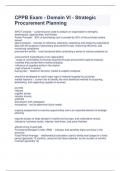Samenvatting
Summary of the midterm chapters
- Vak
- ECB3MTP
- Instelling
- Universiteit Utrecht (UU)
Summary of chapters 14 - 20, 24 - 26 of the book F.S. Mishkin, The Economics of Money, Banking, and Financial Markets, 13 th global edition, 2022, Pearson
[Meer zien]













